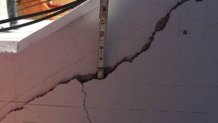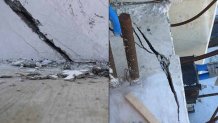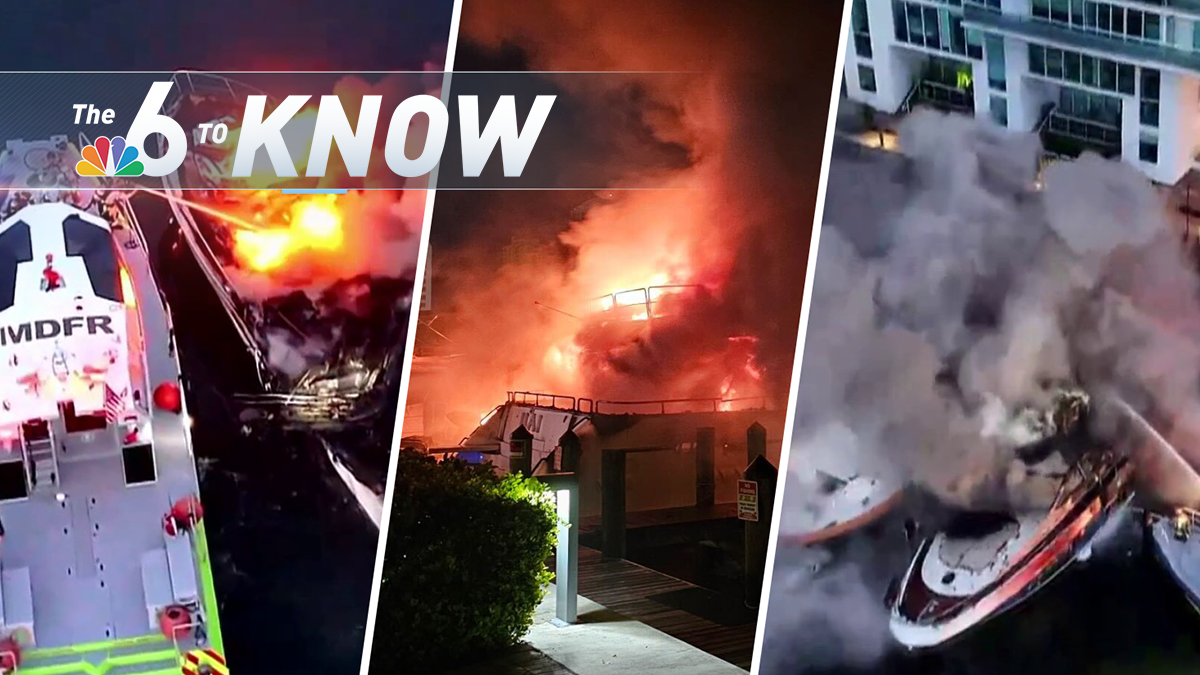Newly released minutes of a meeting held the morning of the FIU bridge collapse reveal engineers dismissed concerns about cracks, assured colleagues it was safe to keep the road below open and said temporary shoring to hold up the bridge as repairs proceeded was not necessary.
Less than five hours before the Florida International University pedestrian bridge collapsed, the project’s engineers dismissed concerns about cracking in the concrete, assured colleagues it was safe to keep the road below open and said temporary shoring to hold up the span was not necessary as repairs proceeded, according to minutes of a two-hour meeting held on site the morning of March 15, 2018.
At 8 a.m., the engineers working for the span’s designer, FIGG Bridge Engineers, climbed onto the bridge deck and saw in person what they had until then only seen in photographs: cracks forming on the north end of what was to be FIU’s signature project.
According to minutes of the meeting that began one hour later in a construction trailer, "FIGG pointed out the cracks look more significant in person" than they did in photographs.
But not significant enough, it turned out, for anyone in the meeting, including a Florida Department of Transportation representative, to take steps to close the road below.


Asked at the meeting why the bridge was cracking, a FIGG engineer told the dozen others present "it just happened," according to minutes released Monday by the Florida Department of Transportation.
FIGG "assured" those in the meeting "there was no concern with safety of the span suspended over the road," the minutes state.
Local
At 1:47 p.m., as a subcontractor was carrying out FIGG’s orders to increase tension in a truss that was cracking, 950 tons of concrete fell to SW Eighth Street, killing five people in vehicles and a worker who was atop the bridge canopy.
Before the meeting even began, FIGG’s engineers had ordered the tightening of steel bars running through the cracking truss. It was supposed to be part of a "temporary" effort to lessen the load on the section of the bridge where cracks were developing.
A full repair was scheduled to begin weeks later, according to the minutes, after another section of the bridge, called the back span, was built over the canal just north of the cracking.
"FIGG mentioned that no repairs should be done now. Once back span is there, Member 11 force will decrease, then repair can begin,” the minutes state. Member 11 is the diagonal truss containing the post-tension bars that were being tightened when the failure occurred.

When a participant from Bolton Perez & Associates (BP&A), the company hired by FIU to oversee construction engineering and inspection, asked whether temporary shoring was needed during the repairs, "FIGG responded that it was not necessary," according to the minutes.
In court pleadings, FIGG has challenged the accuracy of the minutes, prepared by BP&A for its client, FIU. While FIGG sent its own version of events to the National Transportation Safety Board, it has not released them publicly.
In a statement Monday accompanied by the release of the minutes and other records, FDOT Secretary Kevin Thibault said, "The Department has been working with the NTSB to proactively get the restriction (on releasing public records) lifted. We support full transparency by providing all documents related to the March 2018 tragedy that impacted the South Florida community and our entire state."
"Lives were lost and other lives have been changed forever, and we know these families, as well as the citizens of Florida, deserve answers and want closure,” he said. “While we have worked with NTSB allowing for the release of public records that have been requested by the media related to FIU bridge, the Department will wait to comment further until the NTSB releases the final report. In the weeks to come, the many court cases and other various investigations will be on-going and we want to be respectful of those processes, and the families directly impacted by this tragedy."
In all, 13 people are listed as attending the meeting: three from the general contractor, MCM, including the project manager and superintendent; two from FIU; three FIGG engineers (one by telephone); FDOT’s coordinator on the project; and four people from BP&A.
They watched a PowerPoint presentation by FIGG explaining how it designed the "temporary construction loading condition and temporary mechanism" to lessen the load near where cracks were forming, the minutes state.
When FIGG completed its PowerPoint presentation, which included detailed calculations of the loads it projected would result from its repair plan, the questions began.
FIU asked its construction engineering and inspection consultant, BP&A, what it thought about the FIGG presentation.
"At this point we cannot comment, will follow up on this request and expedite in 2-3 days,” the minutes quote a BP&A employee as answering.
But the tightening of the post-tension bars – the first step in adjusting the load on the bridge prior to repairs -- would not wait for days.
A crew from Structural Technologies, a subcontractor, had already been summoned to the site and was preparing at that moment to carry out FIGG’s instructions to add tension to the bars inside Member 11.
FDOT’s representative at the meeting, Alfredo Reyna, requested “a copy of FIGG analysis presentation to give to their structural group.” It was the same FDOT structural group that expressed concerns about the bridge design from its inception, especially the potential for cracking.
The FDOT engineer in that group overseeing the bridge, Tom Andres, was left a voicemail on March 13, two days before the bridge collapsed, by FIGG’s chief engineer, Denney Pate, informing him of the cracks.
FDOT falsely claimed he did not get the message until Friday, March 16 -- the day after the collapse -- because he was out of the office until then. In fact, NBC6 Investigators first revealed, Andres was in the office the morning of the collapse. FDOT now says, while he was in the office, he didn’t listen to the voicemail until the day after the bridge collapsed. FDOT says it has no record proving exactly when Andres retrieved the voicemail.
The minutes of the March 15 meeting suggest some dissension and concern among those present.
At one point, after FIGG’s predictions about the effects of the planned repairs were discussed at length, FIGG noted some diagonal cracking was predicted by its analysis.
Then someone from FIU chimed in to FIGG: "Nothing predicted this cracking."
Reyna, FDOT’s coordinator, then asked FIGG, “Are you going to continue to figure out why it happened?”
FIGG’s response: All we "know is that it just happened."
MCM then asked if there would be further inspection inside the cracks, which photos show had grown to six inches deep in the area where diagonal Member 11 met the vertical Member 12 at the north end.

"FIGG answered that they don’t want to core concrete out” – that is, drill into the cracked areas to determine the extent of the cracks within the concrete. “They want to move forward and seal cracks before being covered,” the minutes state.
Bolton Perez & Associates again raised concerns about the cracks, confirming they had increased in length or depth each day since the bridge was lifted from its roadside construction site, rotated across the then-closed road and placed on supports on the morning of March 10. Negligence lawsuits filed against companies involved in the project allege a Structural employee was so concerned about cracking on March 10, he texted photos of the cracks to his company.
BP&A asked FIGG and MCM if there will be "a crack monitoring plan," according to the minutes. BP&A “had been monitoring cracks and insisted that FIGG/MCM perform the crack monitoring as well. FIGG/MCM had no response."
Toward the end of the meeting, it was again BP&A that seemed most concerned about what was happening – and the lack of analysis regarding what was being proposed to happen in the future.
BP&A asked the FIGG representatives if they were going to stay to watch the post-tensioning procedure, and FIGG said they would not. “FIGG was going back (to its headquarters in Tallahassee) right after this presentation because they had work to do on this,” the minutes state.
FIGG’s PowerPoint ended with a conclusion about its repair design, called a strut-and-tie: "Based on conservative calculations, it is concluded that the design meets LRFD (load and resistance factor design) strength requirement for this temporary condition … and therefore, there is no safety concerns relative to the observed cracks and minor spalls." Spalling occurs when concrete breaks away from the rest of the structure, something photos show occurring near the cracks.

After requesting a copy of the PowerPoint, BP&A asked FIGG if its plan had been "peer reviewed” – double-checked by other engineers to assure assumptions and calculations are correct. BP&A “requested that it wanted more eyes on this and that the more eyes on this, the better. FIGG concurred."
But while those concerns were focused on the repair effort that was to take place weeks later, there was little discussion of the post-tensioning procedure that was about to take place just outside the trailer where they were meeting.
In fact, BP&A, as of the meeting, had not yet seen the exact procedure FIGG was ordering the Structural Technologies crew to do.
From the minutes: BP&A asks FIGG and MCM to provide “the stressing procedure that will be performed on 3/15/18.”
Again: this meeting was being held on the morning of 3/15/18.
MCM replied it will provide it to BP&A, but then "clarified that (Structural) was currently on site to perform the stressing operation with the corresponding stressing procedure."
There is no mention in the minutes of anyone objecting to the re-stressing procedure going forward at that point.
Nor was there much discussion about a temporary alteration FIGG had ordered two days earlier, after MCM sent FIGG photographs of the cracking. FIGG "instructed MCM to install … temporary shims in the pylon base below member 12,” the minutes state. Member 12 was the vertical support that rested on a pylon at the north end of the 174-foot-long main span.
Again, it was BP&A that appears to have expressed the most urgency about the situation, asking MCM if it was “planning on rushing the completion of construction” of the back span and a pylon diaphragm that FIGG said must be completed before it moved to the final phase of its repair plan.
"MCM responded that they are following the schedule but that they will expedite the construction of them," the minutes state.
According to the minutes the following people attended the meeting:
From FIGG: chief engineer on the project, Denney Pate; regional director Dwight Dempsey (by telephone); bridge engineer Eddy Leon;
From MCM: project manager Rodrigo Isaza; superintendent Ernie Hernandez; Pedro Cortes;
From FDOT: Alfredo Reyna, coordinator for FIU bridge, a Local Agency Project;
From FIU: associate vice president of facilities management John Cal; director of facilities construction Patrick Meagher;
From Bolton, Perez & Associates: senior project engineer Jose Morales; project administrator Rafael Urdaneta; construction engineer Carlos Chapman, who would be injured hours later when the bridge collapsed; and inspector Maria Christina Acosta.



